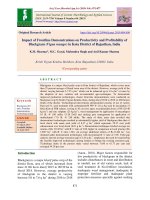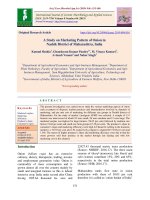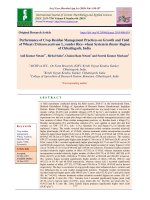Examine the changes in area, production, productivity and major constraints under soybean seed production in Kabirdham district of Chhattisgarh, India
Bạn đang xem bản rút gọn của tài liệu. Xem và tải ngay bản đầy đủ của tài liệu tại đây (325.15 KB, 8 trang )
Int.J.Curr.Microbiol.App.Sci (2020) 9(7): 959-966
International Journal of Current Microbiology and Applied Sciences
ISSN: 2319-7706 Volume 9 Number 7 (2020)
Journal homepage:
Original Research Article
/>
Examine the Changes in Area, Production, Productivity and Major
Constraints under Soybean Seed Production in Kabirdham
District of Chhattisgarh, India
Shashank Sharma1*, Anjali Verma1, Yogesh Kumar Sai2 and G. Bhavani Rao3
1
Department of Agricultural Economics, 2Department of Agri-Business & Rural Management,
3
Department of Agricultural Statistics, College of Agriculture, IGKV, Raipur, India
*Corresponding author
ABSTRACT
Keywords
Randomly, area,
production,
productivity, seed
production& major
constraints
Article Info
Accepted:
11 June 2020
Available Online:
10 July 2020
Study was conducted in Kabirdham district of Chhattisgarh state. 49 soybean seed
producers were selected randomly from two blocks of this district i.e. Kawardha and
Lohara. Soybean seed producers were selected randomly and were considered to collect
the required information on the cost of cultivation and other aspects for the present study.
The secondary data was collected from the Chhattisgarh State Seed and Agriculture
Development Nigam Limited Raipur for examine the changes in area, production,
productivity of seed production of Soybean. Primary data was collected from the soybean
seed producers through personal interview method with the help of well-prepared schedule
for the production for kharif soybean 2016-17 for examine the major constraints under
Soybean Seed Production. The objectives were achieved using exponential function,
tabular, arithmetic and perception analysis. The response of farmers about seed production
constraints namely Unavailability of labor in crop season, Time factor (Delay in payment),
Natural calamities (Rainfall occur during the harvesting and threshing), Low adoption of
recommended package and practices of the crop, Ignorance of severs infestation of insectpest disease control, Unavailability of proper training and guidance, lack of literacy and
technological problem in farm production (low productivity).
poor cook ability on account of inherent
presence of trypsin inhibitor, it cannot be
utilized as a pulse. It is now the second largest
oilseed in India after groundnut. It grows in
varied agro-climatic conditions.
Introduction
Soybean (Glycine max, Linn.) is a leguminous
and self-pollinated crop belongs to family
Leguminaceae and sub-family Papilionoideae
(fabaceae). Soybean is rightly termed as
miracle crop as well as “GOLDEN BEAN” of
the 21th Century because of its unique
qualities. Though, Soybean is a legume crop,
yet it is widely used as oilseed. Due to very
Seed is the most important input in increasing
productivity in agriculture. Inputs such as
fertilizer, water etc. help to realize the
potential imbibed in seed.
959
Int.J.Curr.Microbiol.App.Sci (2020) 9(7): 959-966
Viewed in the context of limited possibility of
expansion of area for cultivation in most
developing countries such as India the role of
seed to increase agricultural production in the
future becomes all the more crucial. It is
believed that genetically good quality seed
alone can increase production up to 20 per
cent.
Lohara block. The study required primary as
well as secondary data. Primary data was
collected from selected soybean seed growers
through personal interview method with the
help of pre-tested questionnaires.
In order to compute the production and
productivity of Soybean in the study area and
secondary data was collected from
Chhattisgarh State Seed and Agriculture
Development Corporation Limited, Raipur
district of Chhattisgarh. The collected data
was analyzed by using average and
percentage techniques for fulfillment of the
objectives
Recognizing the importance of a vibrant seed
industry to augment agricultural production to
meet the challenges posed by the burgeoning
population the Government of India initiated
various policy measures which helped the
growth of the nascent industry. The study is
being conducted with the following specific
objectives: to examine the changes in area,
production & productivity of seed production
of soybean in the study area and to find out
the major constraints in seed production of
soybean in the study area.
Results and Discussion
Changes in area and production under
seed production of soybean
Table no. 3.1, 3.2, 3.3 and fig. 3.4showed the
comparative changes in area, production and
productivity of soybean in Kabirdham district.
In the year 2011, 2012, 2013 and 2014 the
increase in area under soybean cultivation
was 1074.70, 719.80,1006.20 and 100 ha
respectively compare to the base year (2010)
during which cultivated area was 863.80 ha
Materials and Methods
Chhattisgarh state consist 27 districts, out of
these districts Kabirdham district was selected
purposively for the study because its area and
production is maximum for Soybean seed
production. The Kabirdham district has four
blocks,
namely
Kawardha,
Lohara,
Pandariya&Bodla.
The change in production showed increasing
trend from the base year 2010 to 2013 and the
production increased by 5691.45, 5704.97,
8398.51 qt./ha in the year 2011, 2012 and
2013 respectively. The productivity decreased
by 305.01, 130.53 and 131.87 kg/ha in the
year 2011, 2012 and 2013 respectively from
the base year productivity.
Out of these two block namely Kawardha and
Lohara were selected because these two
blocks Kawardha and Lohara contribute
highest area of soybean seed production in
Kabirdham district.
Total 196 soybean seed producer farmers in
Kawardha and Lohara block in which 119
farmers are from Kawardha block and 77
farmers are from Lohara block so 25%
farmers were selected randomly for the
present study. Thus total 49 farmers were
selected out of these 30 farmers selected from
Kawardha block and 19 farmers selected from
In the year 2014, there was no production due
to severe damage to the soybean crop by a
fungal disease sudden death syndrome and
therefore the productivity was zero. In the
year 2015, the area, production and
productivity decreased by 268.30 ha, 9248.55
qt. and 1066.59 kg per ha respectively from
960
Int.J.Curr.Microbiol.App.Sci (2020) 9(7): 959-966
the corresponding base year (2010) due to
damage to soybean crop by heavy rainfall.
The area, production and productivity of
soybean in the year 2016 decreased from the
base year(2010) due to less registered area
under seed production and decreased by
599.00 ha, 4821.71 qt. and 621.62 kg per ha
respectively from the corresponding base
years(2010)
area,
production
and
productivity.
in productivity under soybean cultivation was
85.71, 632.48 and 626.07 kg/ha respectively
compare to the base year (2008) but in 2016
the productivity is higher compare to the base
year which is 620.69 kg/ha more than the base
year productivity.
Major constraints
production
in
soybean
seed
The response of farmers about seed
production constraints namely Unavailability
of labour in crop season, Time factor (Delay
in payment), Natural calamities (Rainfall
occur during the harvesting and threshing),
Low adoption of recommended package and
practices of the crop, Ignorance of severs
infestation of insect-pest disease control,
Unavailability of proper training and
guidance, lack of literacy and technological
problem
in
farm
production
(low
productivity) and other constraints which
directly affected
the
soybean
seed
productivity are discussed in this section.
Table 3.6, 3.7, 3.8 and fig. no 3.2shows the
comparative changes in area, production and
productivity of soybean in Chhattisgarh. In
the year 2009, 2010, 2011, 2012 and 2013 the
increase in area under soybean cultivation
was 2075.15, 2243.35, 2827.61, 3012.86 and
3337.52 ha respectively compare to the base
year (2008) during which cultivated area was
4726.55 ha.
The change in production showed increasing
trend from the base year 2008 to 2013 and the
production increased by 14296.11, 50192.07,
21428.67, 43157.66 and 15741.90 qt./ha in
the year 2009, 2010, 2011, 2012 and 2013
respectively.
The Table 3.9 revealed that for overall 100
per cent seed producer quoted Time factor
(Delay in payment) it was ranked I. Second
one was Natural calamities (Rainfall occur
during the harvesting and threshing ) found
93.87 per cent and ranked II, Unavailability of
labor in crop season found 79.60 per cent and
ranked III, The constraint Unavailability of
proper training and guidance was found 73.47
per cent and ranked IV.
The productivity increased by 3.10, 501.66,
29.60 and 293.40 kg/ha in the year 2009,
2010, 2011 and 2012 respectively from the
base year(2008) productivity.
The productivity decreased by 85.71, 632.48
and 626.07 kg/ha in the year 2013, 2014 and
2015 respectively from the base year (2008)
productivity. In the year 2014, 2015 and 2016
the decrease in area under soybean cultivation
was 470.49, 22436.06 and 3915.46 ha
respectively compare to the base year (2008).
The technological problem in farm production
(low productivity) was found 71.42 per cent
and ranked V. Lack of literacy was found
69.38 and ranked VI.
In the year 2014, 2015 and 2016 the decrease
in production under soybean cultivation was
30112.31, 30875.24 and 21542.55 qt./ha
respectively compare to the base year (2008).
In the year 2013, 2014 and 2015 the decrease
Low adaptation of recommended package and
practices of the crop was found 39.87 per
centand ranked VII. Ignorance of severe
infestation of insect-pest disease control was
found 65.30 per cent and ranked VIII.
961
Int.J.Curr.Microbiol.App.Sci (2020) 9(7): 959-966
Table.1 Area, Production and Productivity of soybean in Kabirdham District
S.No.
Year
Productivity
Total Area(ha)
Total
Production
(qt.)
(kg/ha)
1
2
3
4
5
6
7
2010
2011
2012
2013
2014
2015
2016
863.80
1938.50
1583.60
1870.00
963.80
595.50
264.80
9326.95
15018.40
15031.92
17725.46
78.40
4505.24
1079.75
774.74
949.22
947.88
13.16
1701.37
Source- C.G. State Seed and Agriculture Development Nigam Limited Raipur
Table.2 Changes in Area of Soybean in Kabirdham District
S. No
Year
1
2010 (Base
Year)
2011
2012
2013
2014
2015
2016
2
3
4
5
6
7
Total Area(ha)
Change in Area
863.80
863.80
% Change in
Area
-
1938.50
1583.60
1870.00
963.80
595.50
264.80
+1074.70
+719.80
+1006.20
+100.00
-268.30
-599.00
124.41
83.33
116.48
11.57
31.06
69.34
Table.3 Changes in Production of Soybean in Kabirdham District
S. No
Year
Total
Production(qt.)
Changes in
Production(qt.)
% Change in
Production
1
9326.95
9326.95
-
2
2010
(Base Year)
2011
15018.40
+5691.45
61.02
3
2012
15031.92
+5704.97
61.16
4
2013
17725.46
+8398.51
90.04
5
2014
0
0
00
6
2015
78.40
-9248.55
99.15
7
2016
4505.24
-4821.71
51.70
962
Int.J.Curr.Microbiol.App.Sci (2020) 9(7): 959-966
Table.4 Changes in Productivity of Soybean in Kabirdham District
S. No
Year
Productivity
(kg/ha)
1
2010
(Base Year)
2011
2012
2013
2014
2015
2016
2
3
4
5
6
7
% Change in
Productivity
1079.75
Changes in
Productivity
(kg/ha)
1079.75
774.74
949.22
947.88
0
13.16
1701.37
-305.01
-130.53
-131.87
0
-1066.59
621.62
28.24
12.08
12.21
00
98.78
57.58
-
Table.5 Area, Production and Productivity of Soybean in Chhattisgarh
S. No.
Year
Total Area(ha)
1
2
3
4
5
6
7
8
9
2008
2009
2010
2011
2012
2013
2014
2015
2016
4726.55
6801.70
6969.90
7554.16
7739.41
8064.07
4256.06
2290.49
811.09
Total
Production(qt.)
32082.29
46378.40
82274.36
53510.96
75239.95
47824.19
1969.98
1207.05
10539.74
Productivity
(kg/ha)
678.76
681.86
1180.42
708.36
972.16
593.05
46.28
52.69
1299.45
Source- C.G. State Seed and Agriculture Development Nigam Limited Raipur
Table.6 Changes in Area of Soybean in Chhattisgarh
S. No.
Year
1
2008
(Base year)
2009
2010
2011
2012
2013
2014
2015
2016
2
3
4
5
6
7
8
9
Total Area(ha)
4726.55
Changes in
Area(ha)
4726.55
% in Change
Area
-
6801.70
6969.90
7554.16
7739.41
8064.07
4256.06
2290.49
811.09
+2075.15
+2243.35
+2827.61
+3012.86
+3337.52
-470.49
-2436.06
-3915.46
43.90
47.46
59.82
63.74
70.61
9.95
51.53
82.84
963
Int.J.Curr.Microbiol.App.Sci (2020) 9(7): 959-966
Table.7 Changes in Production of Soybean in Chhattisgarh
S. No.
Year
1
2008
(Base year)
2009
2010
2011
2012
2013
2014
2015
2016
2
3
4
5
6
7
8
9
Total
Production(qt.)
32082.29
Changes in
Production(qt.)
32082.29
% Change in
Production
-
46378.40
82274.36
53510.96
75239.95
47824.19
1969.98
1207.05
10539.74
+14296.11
+50192.07
+21428.67
+43157.66
+15741.90
-30112.31
-30875.24
-21542.55
44.56
157.44
66.79
134.52
49.06
93.85
96.24
67.15
Table.8 Changes in Productivity of Soybean in Chhattisgarh
S. No.
Year
Productivity
(kg/ha)
1
2008
(Base year)
2009
2010
2011
2012
2013
2014
2015
2016
2
3
4
5
6
7
8
9
% Change in
Productivity
678.76
Changes in
Productivity
(kg/ha)
678.76
681.86
1180.42
708.36
972.16
593.05
46.28
52.69
1299.45
+3.10
+501.66
+29.60
+293.40
-85.71
-632.48
-626.07
+620.69
0.46
73.91
4.36
43.22
12.62
93.18
92.24
91.35
-
Table.9 Major Constraints of soybean seed production
S. No.
1.
2.
3.
4.
5.
6.
7.
8.
Constraints relating
Unavailability of labour in crop
Season
Time factor (Delay in payment)
Naturalcalamities (rainfall
occur during the harvesting and
threshing )
Ignorance of severe infestation of
insect-pest disease control
Unavailability of proper training
and guidance
Lack of literacy
Technological problem
production( Low productivity)
Low adaptation of recommended
package and practices of the crop
Respondents (n=49)
Number
Percentage
39
79.60
in farm
964
Rank
III
49
46
100
93.87
I
II
32
65.30
VIII
36
73.47
IV
34
35
69.38
71.42
VI
V
33
67.34
VII
Int.J.Curr.Microbiol.App.Sci (2020) 9(7): 959-966
Fig.1 Change in Area, Production and Productivity of Soybean in Kabirdham District
Fig.2 Change in Area, Production and Productivity of soybean in Chhattisgarh state
In the year 2011, 2012, 2013 and 2014 there
was increase in area under soybean
cultivation was 1074.70, 719.80, 1006.20 and
100 ha respectively compare to the base year
(2010) during which cultivated area was
863.80 ha. The change in production showed
increasing trend from the base year 2010 to
2013 and the production increased by
5691.45, 5704.97, 8398.51 qt./ha in the year
2011, 2012 and 2013 respectively.
was zero. In the year 2015, the area,
production and productivity decreased by
268.30 ha, 9248.55 qt. and 1066.59 kg per ha
respectively from the corresponding base year
(2010) due to damage to soybean crop by
heavy rainfall. The area, production and
productivity of soybean in the year 2016
decreased from the base year(2010) due to
less registered area under seed production and
decreased by 599.00 ha, 4821.71 qt. and
621.62 kg per ha respectively from the
corresponding base years(2010) area,
production and productivity.
The productivity decreased by 305.01, 130.53
and 131.87 kg/ha in the year 2011, 2012 and
2013 respectively from the base year
productivity. In the year 2014, there was no
production due to severe damage to the
soybean crop by a fungal disease sudden
death syndrome and therefore the productivity
In the year 2009, 2010, 2011,2012 and 2013
the increase in area under soybean cultivation
was 2075.15, 2243.35, 2827.61, 3012.86 and
3337.52 ha respectively compare to the base
965
Int.J.Curr.Microbiol.App.Sci (2020) 9(7): 959-966
year (2008) during which cultivated area was
4726.55 ha The change in production showed
increasing trend from the base year 2008 to
2013 and the production increased by
14296.11, 50192.07, 21428.67, 43157.66 and
15741.90 qt./ha in the year 2009, 2010, 2011,
2012 and 2013 respectively. The productivity
increased by 3.10, 501.66, 29.60 and 293.40
kg/ha in the year 2009, 2010, 2011 and 2012
respectively from the base year(2008)
productivity. The productivity decreased by
85.71, 632.48 and 626.07 kg/ha in the year
2013, 2014 and 2015 respectively from the
base year (2008) productivity.
payment), Natural calamities (Rainfall occur
during the harvesting and threshing), Low
adoption of recommended package and
practices of the crop, Ignorance of severs
infestation of insect-pest disease control,
Unavailability of proper knowledge and
guidance, lack of literacy and technological
problem
in
farm
production
(low
productivity).
References
Agarwal, Punit Kumar; Pandey Divya, Yadav
Pushpa and Singh O.P.(2014) Trends of
area production and productivity of
Soybean crop in Madhya Pradesh,
National Academy of Agricultural
science, Vol. 32: 3-4.
Agrawal, Ratan Lal (2006), Seed Technology,
oxford and IBH publishing co. pvt. Ltd.
New
Delhi,
Chapter-6,
Seed
Certification, PP-627-643
Antre, Archana G.(2015), Case Study of
Soybean
Crop
Production
in
Ahmednagar District, Maharashtra
(India). Journal of Commerce &
Management Thought Vol. 6-2: 214225.
Jain, S.C. and Sitaram (2001) Identification of
factor responsible for declining status of
soybean Madhya Pradesh, project report
of Agro Economics Research Centre
(JNKVV): 25-29
In the year 2014, 2015 and 2016 the decrease
in area under soybean cultivation was 470.49,
22436.06 and 3915.46 ha respectively
compare to the base year (2008).In the year
2014, 2015 and 2016 the decrease in
production under soybean cultivation was
30112.31, 30875.24 and 21542.55 qt./ha
respectively compare to the base year (2008).
In the year 2013, 2014 and 2015 the decrease
in productivity under soybean cultivation was
85.71, 632.48 and 626.07 kg/ha respectively
compare to the base year (2008) but in 2016
the productivity is higher compare to the base
year which is 620.69 kg/ha more than the base
year productivity.
The response of farmers about seed
production constraints namely Unavailability
of labor in crop season, Time factor (Delay in
How to cite this article:
Shashank Sharma, Anjali Verma, Yogesh Kumar Sai and Bhavani Rao. G. 2020. Examine the
Changes in Area, Production, Productivity and Major Constraints under Soybean Seed
Production in Kabirdham District of Chhattisgarh, India. Int.J.Curr.Microbiol.App.Sci. 9(07):
959-966. doi: />
966









